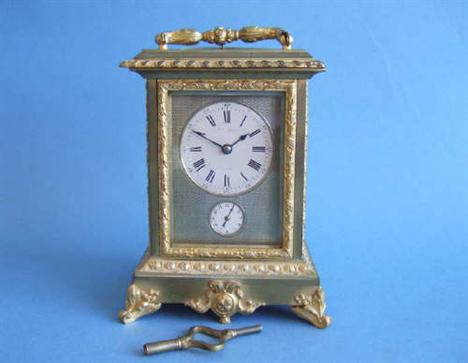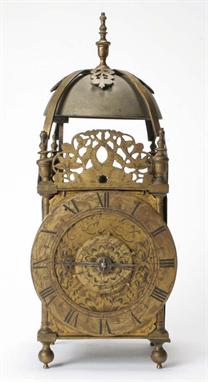14361 Preisdatenbank Los(e) gefunden, die Ihrer Suche entsprechen
14361 Lose gefunden, die zu Ihrer Suche passen. Abonnieren Sie die Preisdatenbank, um sofortigen Zugriff auf alle Dienstleistungen der Preisdatenbank zu haben.
Preisdatenbank abonnieren- Liste
- Galerie
-
14361 Los(e)/Seite
An unusual late 19th Century French lacquered brass Carriage Alarm Clock, with pin escapement and strike on a bell, to a Roman and Arabic chapter ring, (hairlines), with blued steel hands and centre seconds, over an alarm subsidiary, in a cornice case with presentation inscription, height 7”; Together with its original outer travel case
FINE RARE 17TH CENTURY FRENCH VERGE CLOCK-WATCH BY JOSIAS JOLLY, PARIS (1608-1642), striking the hours and alarm on a bell to the inner case, the movement signed ÔJosias Jolly A Paris’, fusee and Ògut, later balance spring and cock, baluster pillars with elaborate piercing to the top plate and barrel, two part silver dial engraved with flowers within a fine pierced integeral silver inner case, shagreen bound pierced outer case with pinwork initials and coronet, swivel pendant, 91mm (strike requires attention)
A French brass carriage clock with push button repeat and alarm by the Couaillet family late 19th century the two-train movement with platform lever escapement and striking on two gongs the cream enamel Arabic numeral dial with subsidiary alarm dial in a corniche type case 12.5cm high excluding handle
A brass lantern clock circa 1660 of posted construction now with anchor escapement and countwheel strike on a bell mounted within the dome shaped bearer above the dial with alarm disc and signed Thomas Knifton at the (crossed keys) in Lothbury Londini within an applied Roman numeral chapter ring with stylised wheat-ear half hour markers with original iron hand beneath dolphin frets with original side doors alarm removed and movement with 18th century restorations 40cm high Thomas Knifton is recorded in Baillie G.H. Watchmakers & Clockmakers of the World as working in London 1640-62. The dial and frame of this clock typify Knifton’s work and now exhibit an attractive mellow colour the movement originally had balance wheel control but was converted to anchor escapement during a refurbishment in the 18th century
An important provincial first period brass lantern clock second quarter of the 17th century of substantial posted construction with cup-and-cover finials and acorn feet the movement now with anchor escapement and countwheel strike on a bell mounted within the dome shaped bearer above the dial with flowerhead mask and repeating floral scroll engraving within an applied Roman numeral chapter ring with cruciform half hour markers with original iron hand beneath heraldic fret signed Elias Browne at Norwich to lower edge with original side doors pendulum and weight alarm removed some restoration 41cm high overall The design and proportion of the frame castings as well as the dial engraving are comparable to the work of William Bowyer of Leadenhall Street London. See Bruce Bill Early English Lantern Clocks 1615-1700 (privately published in 2004) exhibit 2 for a clock attributed to Bowyer. However the detail design of the half hour markers hammer stop and general quality of the frame turnings strongly suggest that this clock originated from the workshop of William Sellwood who is recorded in Baillie G.H. Watchmakers & Clockmakers of the World as working in London 1633-52. Elias Browne of Norwich appears to be unrecorded as a maker however an Edward Browne is recorded as working in the early 18th century. see illustration on front cover
A Brass Lantern Clock, the dial engraved flowers and foliage, and having a silvered alarm disc to the centre, all within a 16 cm diameter silver chapter ring having Roman numerals in a brass case of traditional design, (side panels later replacements) 31 cm high, on an oak wall bracket made by John Makepeace
-
14361 Los(e)/Seite






























